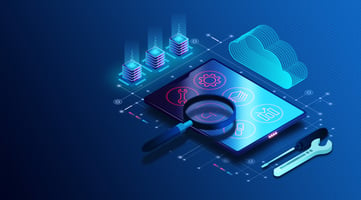Hyperautomation and RPA: How to Revolutionize Business Processes
.png?width=432&height=288&name=Giuseppe%20Mandarino_Blog%20%20(1).png)
By Giuseppe Mandarino, Business Line Manager Software Factory Digital Transformation & Hyperautomation at S2E
The term hyperautomation, coined by Gartner, refers to a strategic business-driven approach that enables organizations to identify and automate a large number of business and IT processes. It combines various technologies, including:
- artificial intelligence (AI)
- machine learning
- event-driven software architecture
- robotic process automation (RPA)
- business process manage-ment (BPM)
- intelligent business process management suites (iBPMS)
- integration plat-forms (iPaaS)
- low-code/no-code solutions
- packaged software
- tools for automating decisions, processes, and activities.
SOURCE: https://www.gartner.com/en/information-technology/glossary/hyperautomation
The digitalization of companies continues to evolve, and process automation is a key element for improving efficiency in terms of time and resources. However, it is essential that the introduction of technology always keeps people at the center, as they are often involved in repetitive, low-value tasks that cause slowdowns in business workflows.
Putting People at the Center of Process Automation
When designing a process automation system, it is crucial to actively involve both process managers and operational staff. This approach defines a Hybrid Center of Excellence (Hybrid CoE), where technology solutions are developed in line with actual business needs, ensuring a concrete and positive impact.
Once automation is implemented, human oversight remains essential. People supervise automated processes, handle any issues, and ensure operational quality. The collaboration between humans and technology increasesr productivity and reduces the stress from repetitive tasks, freeing up resources for more strategic roles.
RPA and Its Evolution Through AI
RPA paved the way for business processes automation, introducing software capable of performing repetitive tasks in a standardized way. The advent of AI has enhanced business workflows through advanced solutions such as Document Understanding and Communication Mining, which leverage AI to optimize data and communication management, improving operational efficiency, and reducing human intervention in less critical activities.
S2E’s Approach to RPA Services
Our integrated approach to RPA and artificial intelligence represents a true revolution in business operations. A method increasingly oriented towards intelligent automation, leveraging AI to create self-learning systems that dynamically adapt to usage needs and continuously improve service effectiveness.
The Tools of Our Intelligent Automation Method
- Process Discovery & Communication Mining: AI analyzes and optimizes business processes, identifying inefficiencies and proposing improvements to reduce operational costs. Communication pattern analysis through advanced algorithms improves team interaction quality.
- Document Understanding: AI-driven document comprehension facilitates the extraction and management of key information, reducing the need for manual intervention and expanding the range of automatable processes.
- AI-Powered Decision Making: AI supports decision-making based on historical data, offering more autonomy and precision than traditional rule-based approaches. This allows companies to make more informed, strategic decisions.
- Software Automation & Human-in-the-loop: automating repetitive tasks improved operational performance and frees up human resources for higher-value strategic and creative work. The collaboration between automated systems and people ensures expected outcomes, maintaining a balance between efficiency and responsibility.
S2E and UiPath: success stories
Thanks to our long-standing partnership with UiPath, S2E offers of certified technologies and expertise aimed at business processes optimization, minimizing human intervention. Together, we have implemented successful solutions in various industries. Here are two examples from the banking and insurance sectors.
1) Finance
Challenge: the bank aimed to scale its operations efficiently without proportionally increasing staff. A key challenge involved managing high volumes of account renewals, which required restoring 400–500 accounts per day. A task that, if not handled efficiently, posed risks of contractual breaches. Additionally, the bank’s audit processes relied heavily on manual reviews of paper documents for Know Your Customer (KYC) compliance, covering only 10% of the documents and failing to meet regulatory standards.
Solution: we leveraged AI-driven Document Understanding and the Action Center to aim for 100% au-tomation in document verification. Initially achieving a 20–40% match rate, the organization improved it to approximately 90% through supervised learning and process refinement. This strategic move streamlined operations, reduced errors, ensured compliance, and boosted employee productivity by shifting focus to higher-value activities. It significantly contributed to the bank’s growth and competitive advantage in digital banking.
2) Insurance
Challenge: the organization needed to reduce customer request processing times while identifying the most frequent reasons behind support tickets. Due to the company’s rapid growth, customer ser-vice faced delays, inefficiencies, and complaints. The wide variety of ticket topics made routing them to the correct department difficult.
Solution: by using UiPath Communications Mining, customer support now ensures that the email inbox is constantly monitored and managed. This allows intervention when necessary, freeing up time to handle more complex requests and reducing overall support time.
RPA as the engine of digital transformation
Automation, initially driven by RPA, has become a key part of the AI revolution in digital transformation management. While driven by deep technological innovation, automation continues to place people at the core. A human-centered approach ensures a balance between technology and human skills, fostering a sustainable and beneficial digital transformation for organizations.
The integration of automation and AI enables better outcomes, ensuring ever more efficient and high-quality processes.






Blog comments